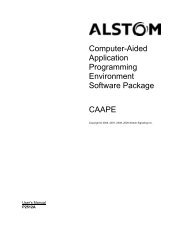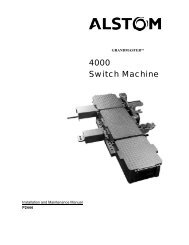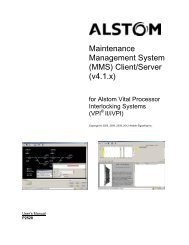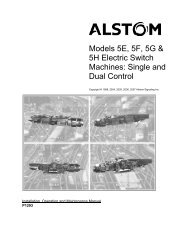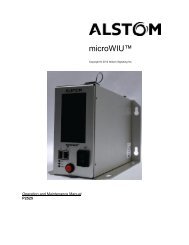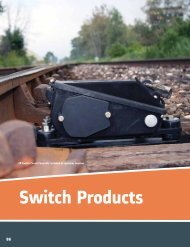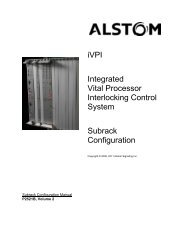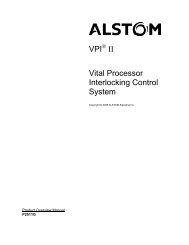You also want an ePaper? Increase the reach of your titles
YUMPU automatically turns print PDFs into web optimized ePapers that Google loves.
Corrective Maintenance<br />
Table 6–11. Mechanical Test and Adjustment Procedure (Cont.)<br />
Step<br />
Procedure<br />
8 If the bridge travel is not acceptable, adjust the bridge travel. Turn the armature<br />
stop screw until the bridge travel measurement is within specification. The screw<br />
must be locked tight in place by the lock nut provided.<br />
Generally, operating values of a relay are easier to obtain when this air gap is<br />
held to the minimum value.<br />
9 Make and break openings for front and back contacts are measured by inserting<br />
the proper thickness gauge between the adjustable residual screw and core<br />
face.<br />
• With the break gauge in place, all specified contacts are open.<br />
• With the make gauge in place, all specified contacts are closed.<br />
2 FRONT<br />
CONTACTS<br />
BACK CONTACT<br />
10 Verify the contact opening measurements meet the specifications indicated in<br />
the appropriate ED sheet.<br />
11 If the contact opening measurements are not acceptable, bend the pressure<br />
plate forcing the contact spring to the proper position to meet the acceptable<br />
make and break values.<br />
With the contact spring properly positioned, the stop plate is bent toward the<br />
contact spring until it just touches the spring. Note that the spring bears against<br />
the pressure plate and touches the stop plate.<br />
If a pressure plate or stop plate is bent too far away from a contact spring, this<br />
can be corrected by bending the plate to stop a little too near the spring and<br />
then bend the plate away from the spring.<br />
12 Use a pressure gauge to verify the contact pressure meets the specifications<br />
indicated in the appropriate ED sheet.<br />
When making contact pressure measurements, place the pressure as close to<br />
the contact as possible (at the center of the extreme outer end of the spring) to<br />
obtain a true reading. Back contact springs must move a minimum of 0.010 inch<br />
from the stop plate; this measurement is taken at the end of the stop plate.<br />
P1457, Rev. Nov/07 6–19 <strong>Alstom</strong> Signaling Inc.




